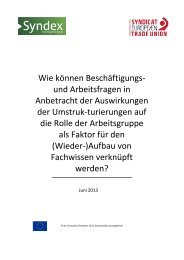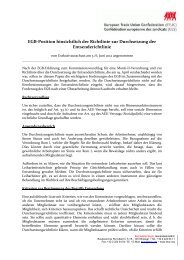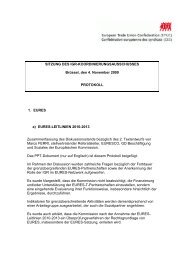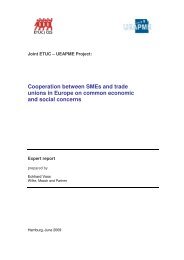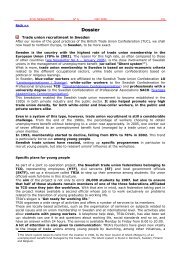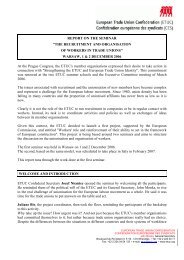Structural reforms and macro-economic policy - ETUC
Structural reforms and macro-economic policy - ETUC
Structural reforms and macro-economic policy - ETUC
You also want an ePaper? Increase the reach of your titles
YUMPU automatically turns print PDFs into web optimized ePapers that Google loves.
<strong>Structural</strong> <strong>reforms</strong> <strong>and</strong> <strong>macro</strong>-<strong>economic</strong> <strong>policy</strong><br />
/ 86<br />
negative dem<strong>and</strong> shock in 2001, which was at least<br />
partly caused by the previous monetary tightening<br />
in 2000 in the first place, the Maastricht regime<br />
failed dismally to offer a cure <strong>and</strong> re-ignite<br />
domestic dem<strong>and</strong>. As stagnation was allowed to<br />
set in, the Maastricht regime in conjunction with<br />
supposedly equilibrating market forces then<br />
nurtured <strong>and</strong> amplified persistent divergences<br />
<strong>and</strong> the corresponding build-up of imbalances.<br />
And yet there is currently much excitement about<br />
a supposed recovery apparently underway at last.<br />
Pre-emptive cheers may be unfounded. In the<br />
context of the four-year global boom that started<br />
in 2003, the euro area has been the only world<br />
region that has managed to stagnate throughout.<br />
Of course, potential growth estimates have been<br />
adjusted downwards, which conveniently helped<br />
to close the negative output gap through statistical<br />
fudging rather than <strong>policy</strong>. Today, the global<br />
environment can hardly get any better, it seems<br />
almost bound to get worse. The ECB embarked on<br />
what it considers a ‘normalisation’ of interest rates<br />
(i.e. tightening) even before any compelling signs<br />
of a revival in domestic dem<strong>and</strong> had emerged.<br />
With stagnation-oriented monetary policies set to<br />
continue <strong>and</strong> fiscal tightening ‘no matter what’ in<br />
the pipeline as well, the results will be just that:<br />
stagnation.<br />
Meanwhile, Germany’s beggar-thy-neighbour<br />
strategy poses another serious threat to the<br />
viability of EMU in Europe. Proponents of EMU<br />
should realize that it is first of all the Maastricht<br />
regime that requires structural reform. <strong>Structural</strong><br />
reform to unleash market forces in full while<br />
failing to reform the ill-conceived Maastricht<br />
regime will lead not to competitive stability, but to<br />
competitive divergence instead.<br />
References<br />
• Aghion, P. <strong>and</strong> Howitt, P. 2005. Appropriate<br />
growth <strong>policy</strong>: a unifying framework, The 2005<br />
• Joseph Schumpeter Lecture, European Economic<br />
Association, Amsterdam 25 August 2005.<br />
• Bibow, J. 2001. Making EMU work: Some lessons<br />
from the 1990s, International Review of Applied<br />
Economics, vol. 15(3): 233-259.<br />
• Bibow, J. 2005a. Germany in crisis: The unification<br />
challenge, <strong>macro</strong><strong>economic</strong> <strong>policy</strong> shocks <strong>and</strong><br />
traditions, <strong>and</strong> EMU, International Review of<br />
Applied Economics, vol. 19(1): 29-50.<br />
• Bibow, J. 2005b. Refocusing the ECB on output<br />
stabilisation <strong>and</strong> growth through inflation<br />
targeting?, <strong>ETUC</strong> conference.<br />
• Bibow, J. 2006a. Inflation persistence <strong>and</strong> taxpush<br />
inflation in Germany <strong>and</strong> the Euro area: A<br />
symptom of <strong>macro</strong><strong>economic</strong> mismanagement,<br />
IMK Studies 12006.<br />
• Bibow, J. 2006b. Germany has not caught up<br />
with the rules of the game, Letter to the Editor,<br />
Financial Times, 24 April 2006.<br />
• De Grauwe 2005. Towards an intelligent Stability<br />
<strong>and</strong> Growth Pact, <strong>ETUC</strong> conference.<br />
• ECB 2003. Inflation differentials in the euro area:<br />
potential causes <strong>and</strong> <strong>policy</strong> implications, September.<br />
• ECB 2005. Monetary <strong>policy</strong> <strong>and</strong> inflation differentials<br />
in a heterogeneous currency area, Monthly<br />
Bulletin,May,pp.61-77.<br />
• Horn, G. 2006. <strong>Structural</strong> unemployment <strong>and</strong><br />
low growth potential as a self-fulfilling prophecy,<br />
<strong>ETUC</strong> conference, 20-21 March 2006, Brussels.<br />
• Issing, O. 2006. ‘Der Euro hat ein langes Leben’,<br />
Im Gespraech, H<strong>and</strong>elsblatt, 29 May 2006.<br />
• Mundell, R. A. 1961. A theory of optimum currency<br />
areas, American Economic Review, 51: 657-75.<br />
• OECD 2004. Euro Area Survey.



